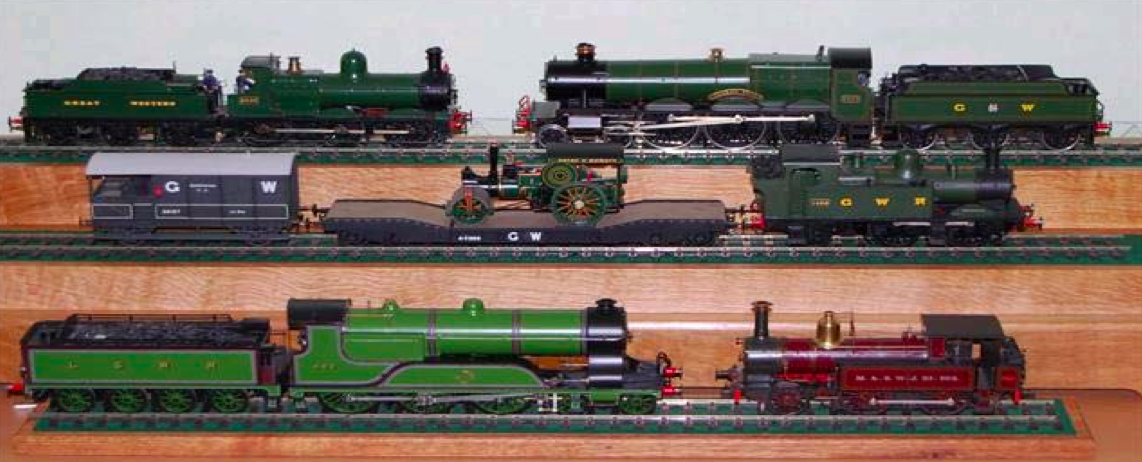Let me start off by asking just 3 questions!
1. How many major railway companies built lines through Wiltshire?
2. How many stations were opened in the county?
3. How many stations are open now?
The answers are 3, 92 and 14. That is to say, 3 railway companies built lines through Wiltshire, the largest being the Great Western Railway. The second largest undertaking was the London & South Western Railway and the third line, quite minor really, was the Midland and South Western Junction Railway which ran from Cheltenham to Andover via Cirencester, Swindon, Marlborough, Savernake and Ludgershall. That line closed in September 1961 through lack of traffic, but during the two World Wars it was heavily used with trains travelling from the Midlands mainly to the army camps on Salisbury Plan and to the port of Southampton.

Display with engines representing the three railway companies which had lines running through Wiltshire. Photo: M. Rumsey
The main Great Western line opened for business throughout the 118 miles from London to Bristol on the 30th June 1841, when Box Tunnel was fully completed. Until that point, coaches transferred the passengers between Bath and Chippenham in the few months leading to that day when Thomas Harvey, with Daniel Gooch, the GWR’s Locomotive Superintendent, brought the first train through Corsham Station. Our station finally closed, following the Beeching Report, on 4th January 1965, the goods depot having closed two years previously. The London & South Western Railway was centred on the City of Salisbury and first arrived there from Southampton, then later it was connected through to London and onward, via Wilton & Tisbury, to Exeter, Plymouth and Cornwall.
Brunel designed a brilliant railway between London and Bristol and the whole line was virtually flat except in 2 places, and those were in Wiltshire – Dauntsey bank and Box Tunnel were both on gradients of 1 in a 100. For years a banking engine was employed at Box to assist goods trains through the tunnel, but this was stopped in 1919 when more powerful engines were available.
Corsham was a very busy station, sending away thousands of tons of stone over the years. During the Second World War tens of thousands of tons of ammunition from the Central Ammunition Depot, which was situated next to Box Tunnel, was sent out on trains bound for various ports in Southern England. The station buildings were quite simple in design with the booking office, station master’s office etc. on the level with the road and footbridge, while on the platforms two simple shelters gave the waiting passengers some protection against the elements and speeding through trains. Box had a much finer Brunel designed stone built structure and Chippenham still retains its Brunel- designed main building, now, of course, a fully listed structure. The four gateposts, which are still in position at Chippenham station, are made from broad gauge rails (Barlow designed), and these two are listed structures. Bradford on Avon is by far the most complete Brunel designed structure built in 1851, but unfortunately the town had to wait until 1857 before the rails and trains arrived!!
Dilton Marsh Halt had the privilege of having a poem written about it by Sir John Betjeman. When the halt was rebuilt a few years ago, a copy of the poem was placed in a frame for display on the platform and this was unveiled by Sir John’s daughter, Candid Lycett-Green. Forty years ago, at Dilton Marsh, if you required to buy a ticket, you needed to walk to the 6th house up the hill and purchase said ticket from Mrs Roberts, can you imagine that happening today? Wiltshire also boasted having four sets of towns/villages with two stations in each – these were Swindon, Marlborough, Savernake and Salisbury. Marlborough and Savernake also rejoiced in having their stations named High Level and Low Level, something similar to those at Wolverhampton.
During the 169 years that our county has had railways running through its environs, there have been only 7 noted accidents, the most serious being at Salisbury LSWR station in July 1906 when 24 passengers and 2 crew were killed because the train approached the station at too high a speed causing the engine and coaches to be derailed and crashing into another train. Thingley Junction saw two accidents, one in November 1875, when one train ran through a red signal and crashed into a passing train causing the guard to be killed and 12 passengers injured. Virtually the same thing happened again at the junction in January 1907, but on this occasion, no one was killed or seriously injured. Box Tunnel has only seen one accident and that happened on September 16th 1893, when engine no: 3021 Wigmore Castle, broke its front axle, thus derailing the engine and coaches, but no one was injured and the engine, together with other members of that class, were rebuilt as 4-2-2’s, one of the most beautiful looking engines Swindon Works ever produced.
So, for the future, how will things progress? The 14 stations still open are, Chippenham, Swindon, Avoncliff Halt, Bradford on Avon, Trowbridge, Westbury, Dilton Marsh Halt, Warminster, Salisbury, Dean, Tisbury, Pewsey, Great Bedwyn and Melksham (with only 2 trains stopping each day). Will Corsham ever have a station again, well I certainly hope so and hopefully, so do many other people in the area.
Bibliography:
Wiltshire Railways by Colin G. Maggs, published by Halsgrove.
Wiltshire Railway Stations by Mike Oakley, published by the Dovecote
Michael Rumsey
